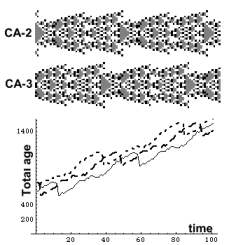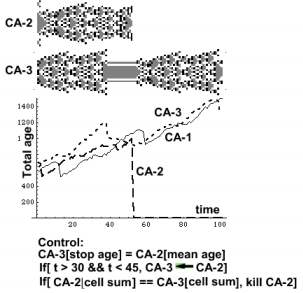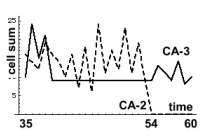Comparator
In the next experiment, each CA sums up its cells, and when both CA come up with equal
cell sums, CA-2 is killed. The
image portrays two CA evolving asynchronously, and since the above condition
is not met, they live happily ever after. The graph depicts total ages
of three CA. CA-1 is the stem process, and the other two are transient
processes
CA-3 stop age
is controlled by CA-2 mean age. Since CA-3 cell ages are below stop
age the CA evolves as usual. From time 30
– 45 CA-2 donates its
age increment to CA-3, which brings
cell ages closer to stop age,
and CA-3 pauses. Both CA still compare their cell
sums. At t = 53 both cell sums are equal and at t=54 CA-2 dies.
Since CA-2 is dead stop age = 0, and CA-3 starts aging again. Note that during its pause it lost
age, and now it regains it.
Both cell sums oscillate, then CA-3 pauses,
at t=53 they meet, and at t=54 CA-2 dies.
Indicator
The condition which specifies
the outcome
after
the two cell sums become equal, indicates when this event happens. It is an
indicator condition. Without the killing of CA-2 we would not have
been aware of this event. We might
prefer a more benign outcome, like planting
a zygote, and creating a new process.
Setup
nca3 zygote -> effect[no,1000]; go[50]; go[60];
go[70] storeparams; restoreparams If[j >30 && j < 45, donate[3,
2]]; If[sa[[2]] == sa[[3]], killca[2]; move[3, nowdat[[2 , 7]]-10]; go[100];
Previous
page
Next page



